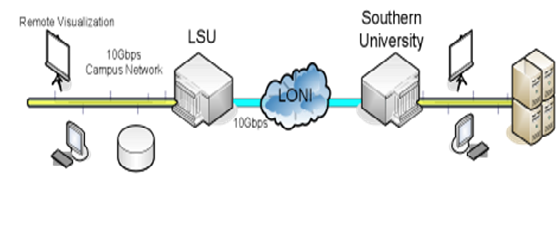CRON
Click here to start using CRON
Goals
Bridging the gap between physical networks and large scale scientific research
Objectives
Next generation networking and computing research, distributed computing for computational sciences(fluid dynamics, bioinformatics etc.), remote visualization
Example Scenario
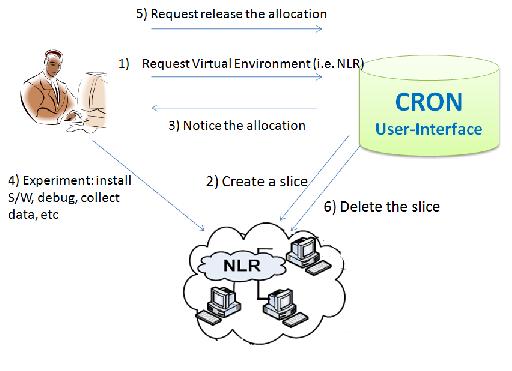
Scope
This effort provides a reconfigurable optical network emulator aggregate (CRON) connected to the GENI backbone over Louisiana Optical Network Initiative (LONI). The role of optical network emulation in GENI is to provide a predictable environment for repeatable experiments, and to perform early tests of network research experimentation prior to acquiring real network resources. The tools and services developed by this project will integrate with the ProtoGENI suite of tools. The aggregate manager and network connections between LONI and GENI for this project will also allow other LONI sites to participate in GENI.
A basic workflow of integration of CRON with ProtoGENI is similar to those of current federations among ProtoGENI and the outher clusters shown in Figure 1 because the CRON testbed adopts the architectures and protocols of Emulab and ProtoGENI and modifies them based on characteristics of different resources at CRON, such as hardware emulators, a high capacity 10Gbps switch, and users opt-in control fitted to scientific appbrcation users.
All CRON's resources, such as 10Gbps paths, virtual built-in optical networks (NLR, LONI, Internet2, etc), and computing resources, will be defined based on the resource specification (RSpecs). Those defined resources will be reported to the ProtoGENI Cleaninghouse so that any user at other federated sites can share them at an assigned sbrce. The brst of defined resources, which will be given to the ProtoGENI cleaning house, are following:
1) four 10Gbps virtual optical networking and computing environments 2) four 5Gbps virtual optical networking and computing environments to mange and exchange the information of defined resources, management, control data, CRON will host two servers, an aggregate manager and a component manager administrating resources and sbrces with common global identifiers (GID).
Below figure shows the implementation of Federation of CRON into ProtoGENI Cluster C at the Spiral 2
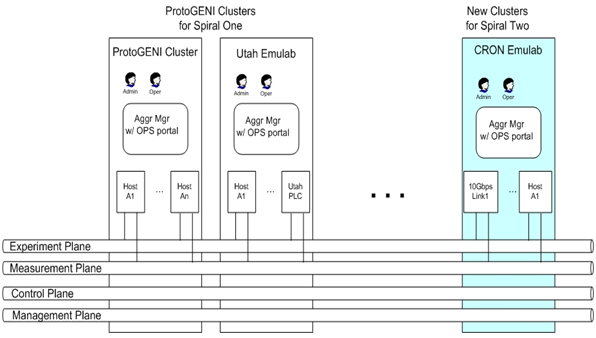
Current Capabilities
CRON is the project funded by NSF MRI (Major Research Instrumentation) program, which builds a virtual high speed optical networking and computing testbed. The CRON testbed can provide up to four 10Gbps optical hardware emulated paths, four 5Gbps optical software emulated paths, and 16 high-end workstations attached to those paths simultaneously. A large number of application developers and networking researchers can share those virtually created high speed networking and computing environments without technical knowledge of networks and communications and without interference of other users. This virtual feature of CRON is exactly matched to the concept of GENI - Virtualization and Other Forms of Resource Sharing.
The cyberinfrastructure, CRON, provides integrated and automated access to a wide range of high speed networking configurations. Figure 1 shows how CRON can be reconfigured to emulate such optical networks as NLR (National Lambda Rail), Internet2, LONI (Louisiana Optical Network Initiative) configuration, or purely user-defined networks having different networking characteristics such as bandwidth, latency, and data loss rates. Moreover, users can dynamically reconfigure whole computing resources, such as operating system, middleware, applications, based on their specific demands. Due to the automated and reconfigurable characteristics, all types of experiments over CRON will be repeatable and controllable. This reconfigurable feature of CRON coincides with that of GENI - Programmability
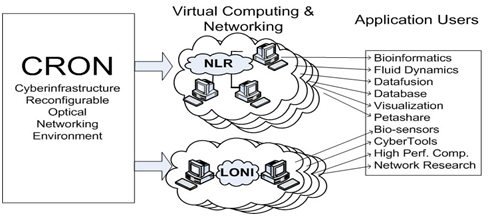
Architecture of CRON

|

|
Above figure shows the architecture of the CRON, which consists of two main components: (i) hardware (H/W) components, including a 10Gbps switch, a 1Gbps switch, optical fibers, network emulators, and workstations; and (ii) software (S/W) components, creating an automatic configuration server that will integrate all the H/W components to create virtual networking and computing environments based on the users' requirements. All components are connected at two different networking planes: a control plane connected with 100/1000 Mbps Ethernet links and a data plane connected with 10 Gbps optical links.
To allow access from outside networks, such as Internet2, NLR, and LONI, and to connect to external compute resources, the switch at the data plane has four external 10 Gbps optical connections that will extend the capacity of CRON and integrate it with existing networks and projects for the purpose of cooperative scenarios shown in the Figure
Due to the high cost of the network hardware emulators, we will connect them to only four optical links that will be allocated to satisfy demands over 5 Gbps of bandwidths. The remaining links will be connected to machines running software emulators. More precisely, we utilize the NIST Net emulator. This emulator can only support up to 5 Gbps of bandwidth due to computing overhead on the CPUs of the machines they run on
All components of CRON, except the remote access clients, are located at LSU, which already has established 10 Gpbs optical paths to LONI and Internet2. Although all computing and networking resources are located at LSU, CRON provides virtual networking and computing environments to users from different physical locations
Collaboration with GENI(Global Environment for Network Innovations)
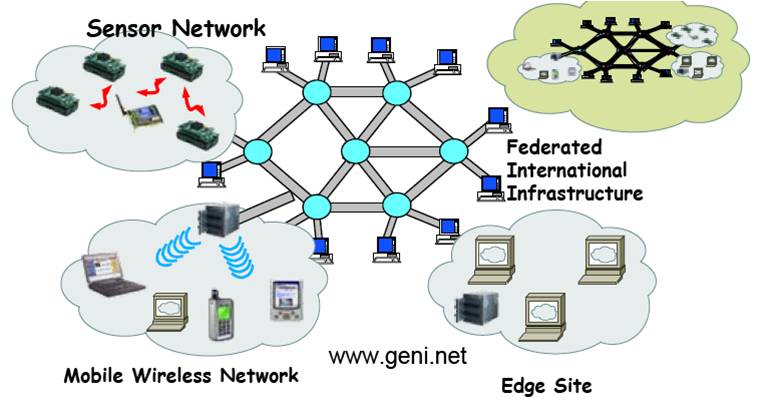
Connectivity of LONI and I2 for protogeni
LONI network has established a 10Gbps connection to Internet2 since the end of 2009 (see the following weather map of LONI network).
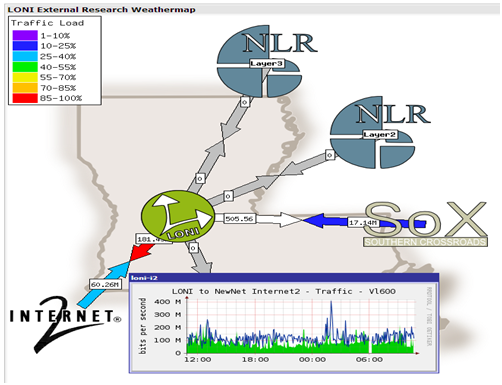
To manage connectivity between LONI and Internet2, the user should login to OSCAR Inter Domain Controller (IDC). While creating a new reservation, user should specify the following parameters: Source and Destination hosts may be specified (e.g. by a DNS host name, IP address or as a topology link identifier), Bandwidth (in Mbps), start date, start time and end date, end time.
Here is a limitation that one reservation can be made for maximum 24 hour i.e. that reservation will be cancelled automatically after 23 hour and 59 minute and 59 second. As we are using layer 2 connection, user should provide layer 2 parameters such as vlan tag while reserving a new connection. It is suggested to use numbers within range of 3000-4000 as vlan tag number to avoid conflict with existing vlans (as common vlan numbers are in the range of 1000).
Connectivity of CRON & Internet2 via LONI
An optical fiber between CRON testbed (which was deployed at the first floor of the Frey building inside Louisiana State University) and a switch of LONI has been deployed. The LONI switch is connected to the internet2 network through Internet2 ION service. Our connection between CRON testbed and the ION is done using the IDC server. This connection can be maintained and operated through this IDC server. This has been successfully tested by LONI administrators. Through this IDC interface, bandwidth can be reserved in the internet2 for the experiment. Right now, LONI cannot handle dynamic setting up of different control parameters through scripts. So they should be set up manually by using GUI and login.
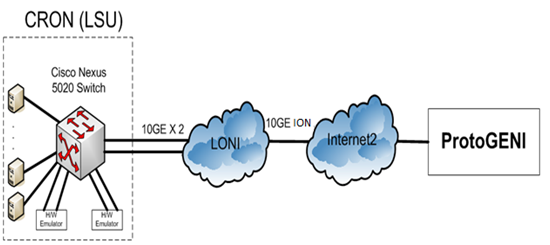
After that, we have completed a test of the ION connection between the temporary Vlan assignment for CRON on the LONI switch (www.loni.bato.dcn.internet2.edu) and BBN (POC of BBN: Heidi Dempsey) successfully. BBN has also tested the Vlan
Since there were only few GENI sites which have the Internet2 ION service, we could not perform the connection test from CRON testbed to other ProtoGENI sites. This test will be done to confirm end to end connectivity
To build a circuit to Layer 2 connection one should select www.loni.bato.dcn.internet2.edu as the local URN and set the system to a predefined/allocated tagged vlan. The system will translate vlans, so users have to make sure that s/he has the correct Vlan set on his/her side. It does not have to match the remote Vlan Number. Users have to keep in mind that this is an allocation reservation system and s/he has to make sure that his/her requests fit the bandwidth and time slots available
Connectivity with Southern University
Our goal is to actively involve minority institutions and underrepresented students in this project. As a preliminary step towards this broader outreach, we have already established an experimental testbed connection between LSU and Southern University through LONI to perform networking experiments as shown in Figure 4. Southern University is one of the nation's largest Historically Black Colleges & Universities. Thus the broader impact of CRON at Louisiana State will be to enable underrepresented minority institutions, which suffer the last mile problem and cannot access high speed networking resources, to perform experiments and researches. We also actively plan to publicize and advertise research opportunities in CRON at our annual departmental workshop for incoming freshman undergraduates and interested high-school students. This annual workshop in which the PIs participated in 2008 is called Computer Science Intensive Orientation for Students (CIOS) and covers basic introductions to key aspects of computer science as a discipline and a profession. In 2010, we plan to use the workshop to introduce freshman computer science students to the challenging field of networking research through CRON presentations and demos. We also hope to actively increase undergraduate and high-school student participation in the project through summer internships as part of the LSU Chancellors undergraduate research program which involves mentoring honors undergraduate students
